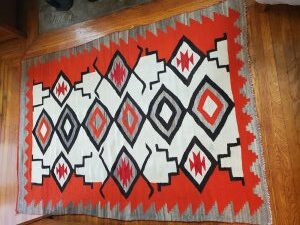 HT inherited two Navajo rugs from her great-grandfather’s ranch. These unique, authentic, and gorgeous rugs appear in remarkable condition for almost 100 years old.
HT inherited two Navajo rugs from her great-grandfather’s ranch. These unique, authentic, and gorgeous rugs appear in remarkable condition for almost 100 years old.
Her great-grandfather farmed citrus and avocados on his ranch on Shepard’s Mesa in Carpinteria. This early 20th century businessman imagined a hacienda adobe for the main house at the ranch. He hired artisans from Mexico to build a house with bedrooms opening to a center courtyard.
I love the bold colors and design. If a Navajo rug speaks in this straightforward yet symbolic visual language, you know you have something special. Together the pair of rugs is worth over $3,000.
How I Analyzed and Dated the Navajo Rugs
I researched four factors to determine age and importance:
- color and design
- materials used
- unique marks to determine geographic origins and age
- deep spiritual role certain motifs and markings play in these weavings
The ‘early’ rugs, mid to late 19th century, show clean, clear, abstracted shapes that let the imagination fly. Or as some say, “Let it follow the path of the wind.” Similarly, the design itself also allows the imagination to fly with the wind. A good example of this “flight” is the imaginatively aggressive style called the “storm pattern.” An artist weaves the path of the lightning itself into a shape as the theme of a rug.
HT’s rugs date from the first quarter of the 20th century, and look in rare condition. Pests often destroy wool. I believe they have a cotton background, which means they could date before 1910. These may use a type of wool from the Navajo-Churro sheep, or plant yarns such as sumac, yucca, and juniper. Both rugs “speak” in that true, bold, abstracted visual language, the patterns authentically streamlined and minimalistic. The more circular shapes indicate later period rugs, and the commercial copies made still later appear flashy and busy. I think of some neon-colored Pendleton Navajo-style fabrics and wince.
Natural Dyes
Most importantly, HT’s rugs exemplify natural plant or insect-based dyes, not synthetic, chemical aniline dyes. Invented in 1856, American Southwest Tribal artists didn’t use those till the mid-20th century. Natural dyes create multi-toned colors, with subtle changes in color in each dye lot. HT’s rugs show true natural dye colors of brown, indigo, white, and madder red.
The main classic designs of Navajo rugs are associated with the locations of the early trading posts where a style predominated. “Two Grey Hills” originated in 1910 from a post in Northwest New Mexico, which featured rugs in four-fold symmetrical geometric design in earth-tones and reds, blacks, and creams. The classic “storm” pattern is best described as a design like a fierce thunderstorm feels with spiked and jagged lines.
The style “Crystal” is named for the trading post’s location in the Chuska Mountains. We see this style in HT’s first rug. The shapes resemble the iron cross, called “whirling logs.” We also see hooks and frets. The log is the mythical hiding place of a warrior assisted by the gods as he escapes down a river. Imagine him whirling in the water.
HT’s Second Navajo Rug Style
“Ganado Red” gives hints of the zig-zag style “Red Mesa” outline. Ganado features a defined central motif, notable boarders, and a diamond lozenge design. The classic Teec Nos Pos design (Navajo: T’iis Názbąs) originated in the northwest corner of Arizona, and borrowed from the intricacies of Persian rugs.
The final classic design is the Yei, which imagines those benevolent stick figured spiritual beings, also seen in Navajo sand paintings, along with cornstalks and arrows.
I picture these rugs in the 1920s Santa Barbara hacienda on that family ranch. HT said it eventually became subdivided. Appropriately Native American culture represented on that ranch in Carpinteria, known for the rich culture of the Chumash Native American people. These rugs are important to retain. They are organic, few of them remain, and original rugs of the peoples from the Four Corners of this age are rare, as more modern rug styles catered more to the “Western” taste. The rug styles and visual language live on as there are talented modern Navajo Native American weavers that are considered great artists still weaving today.
Pingback: Value Characteristics of Native American Rugs - Elizabeth Appraisals